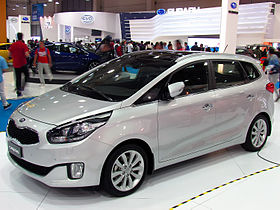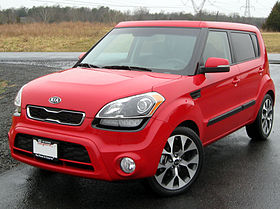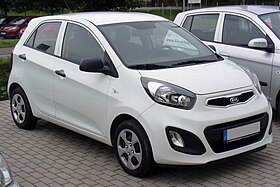From October 1975 the Grand Familia was built in South Korea by Kia Motors, with the 1272 cc 72 PS (53 kW) engine and four-door bodywork. Originally it was sold as the Brisa II, alongside the smaller Brisa, based on the Familia Presto. The early cars had rectangular lights, but in December 1976 an updated version with single round headlights was introduced, called the Kia K303. A station wagon model of the K303 was added in 1978. Production ended in 1981, when the license expired. As part of a nationwide industrial plan Kia was then excluded from building passenger cars until 1986.
суббота, 2 ноября 2013 г.
Kia Brisa
From October 1974 until 1981, Kia Motors manufactured a variant of the second generation Familia as the Kia Brisa at their first integrated automobile manufacturing facility, the Sohari Plant in Gwangmyeong, South Korea. Production originally commenced in 1973 in the form of the Brisa B-1000 pickup truck, but passenger car production (originally as the "Brisa S-1000") only commenced later. Brisa comes from the Spanish/Portuguese word for "breeze". The Brisa was equipped with a 62 PS (46 kW) 1 litre Mazda engine. In October 1975 a 72 PS (53 kW) 1,272 cc engine was added to better compete with the 1.4 liter Hyundai Pony. Production came to an end after the new military dictator Chun Doo-hwan enforced industry consolidation, meaning Kia had to give up passenger cars and focus entirely on light trucks. The original version of the Brisa received a slightly different front end from the original Familia, featuring twin headlights. Later (presumably after the introduction of the 1300 engine) single headlights were used. In total, 31,017 Brisa passenger cars were built. Including the pickups increases the totals to 75,987, of which a total of 1,526 were exported. Exports, Kia's first, began with a shipment of 31 Brisa B-1000 pickups to Qatar in 1975. The larger Grand Familia/818 was also built by Kia with the 1,272 cc engine, originally as the Brisa II and later as the K303.
Kia Bongo
The Kia Bongo (Hangul:기아 봉고), also known as the Kia K-Series or Kia Besta, is a pick-up truck and van produced by the South Korean manufacturer Kia Motors since 1980. The Bongo was first launched in 1980 under the name Bongo. In 1997, the third generation generation Bongo Frontier was launched. As of 2004, the Kia Bongo was in its fourth version, confusingly sold as the Kia Bongo III. "Frontier" was dropped from the name with this revision.
Kia Granbird
The Kia Granbird is a commercial bus manufactured by Kia Motors based on the Hino Selega-inspired platform and for a brief period of time by Asia Motors. Production started in 1994, and the exterior look stayed the same until a cosmetic update in 2007 for 2008. The Granbird is manufactured at Kia's Gwangju plant, which also makes the Soul, Sportage, Rondo, and Kia's commercial and military trucks. The Granbird is only sold in selected markets.
Kia Mohave
The Kia Mohave, marketed in North America as the Kia Borrego, is a sport-utility vehicle (SUV) manufactured by the South Korean-based Kia Motors. The vehicle debuted in 2008 in the Korean and US markets. The Kia Borrego is named after the Anza-Borrego Desert State Park in California; Borrego means "bighorned sheep" which can be found in the state park.
Kia Carnival
The Kia Carnival is a minivan manufactured by Kia Motors, introduced in September 1998, marketed globally under various nameplates — prominently as the Kia Sedona — and currently in its second generation. First generation models remain in production (e.g., in China). Second generation models have been marketed since model year 2006 – including as a rebadged variant in the United States, the Hyundai Entourage for model years 2007–2009. Beginning in 2010 certain global markets (e.g., the UK) of the second generation model began receiving updated equipment, engine choices and Kia's corporate grille, known as the Tiger Nose, as designed by Kia's design chief, Peter Schreyer.
Kia Carens
The Kia Carens is a compact MPV launched in 1999 by the Korean manufacturer Kia, now in its fourth generation, and marketed worldwide under various nameplates — prominently as the Kia Rondo. The model was discontinued in Australia in 2001, with production continuing elsewhere for a new model which was launched in 2002. In 2006, Kia presented a second generation Carens for model year 2007. The Carens/Rondo followed Kia's introduction at the 2005 Frankfurt Motor Show of the Multi-S, essentially the Carens/Rondo in concept form — the S standing for Sporty, Spacious and Smart. The Multi-S differed significantly from the production model only its inclusion of a dual-panel sunroof running the length of the roof.
Kia Venga
The Kia Venga is a mini MPV produced by the South Korean automakers Kia Motors and Hyundai Motors, having debuted at the 2009Frankfurt Auto Show. The Venga is built on the same platform as the Hyundai i20, Hyundai ix20, and Kia Soul. The Venga employs Kia's corporate grille, known as the Tiger Nose, as designed by Kia's design chief, Peter Schreyer. In December 2009, the Venga won Germany's iF Design Award.
Kia Rio
The Kia Rio is a subcompact automobile manufactured and marketed by Kia Motors since August 2000 and now in its third generation. Body styles have included a five-door hatchback and four-door sedan body styles, equipped with inline-four gasoline and diesel engines, and front-wheel drive. The Rio replaced the first-generation Pride—a rebadged version of the Ford Festiva—and the Avella, a subcompact sold as a Ford in some markets. A second generation was introduced in 2005 in Europe and 2006 in North America, sharing its platform with the Hyundai Accent, a subcompact manufactured by its sister Hyundai Motor Company. In South Korea, the second generation was marketed as the New Pride. In 2010, the Rio was facelifted to incorporate Kia's "Tiger Nose" grille, and for model year 2012, Kia introduced the third generation Rio.
Kia Ray
The Kia Ray EV is an electric-powered mini MPV manufactured by Kia Motors. The initial roll out was a limited production of 2,500 units destined for the South Korean government fleets, scheduled to be deployed in 2012. Global production is expected in 2014. In May 2013 a fleet of 184 Kia Ray EVs were deployed in Seoul as part of a carsharing service called "Electric Vehicle Sharing” at a rate of US$5 per hour. The service has 15,000 registered customers. The Ray EV is the automaker's first production battery-electric vehicles. The electric vehicles is powered by a 50 kW (67 hp) electric motor, with a 16.4 kW·h lithium ion battery that allows an all-electric range of 138 km (86 mi) depending on driving conditions. The Kia Ray is also available in non EV types equipped with gasoline and bi-fuel with a gasoline and liquefied petroleum gas (LPG) combination.[citation needed] Both engines are available in four trims - Deluxe, Special, Luxury and Prestige. Only available in the local Korea domestic market, both engines produce similar power and outputs. The gasoline engine generates 78ps/6,400rpm and 9.6 kg.m/3,500rpm. Both engines capacity is 998cc with fuel economies generating 17 km/l for gasoline and bi-fuel delivering 16.6 km/l on gasoline mode and 13.2 km/l on LPG mode. Gasoline engine models weigh in at 998 kg with bi-fuel models weighing in at 1,042 kg. Both are equipped to a 4 speed automatic and currently sold in the Republic of Korea.
Kia Picanto
The Kia Picanto is a city car produced by the South Korean manufacturer Kia Motors since 2004. It is also known as the Kia Morning in South Korea, Hong Kong and Chile, Kia EuroStar in Taiwan, Kia New Morning in Vietnam and the Naza Suria or Naza Picanto in Malaysia. The Picanto is manufactured exclusively at a joint-venture plant with Donghee in Seosan, South Korea.
Kia Optima
The Kia Optima is a mid-size four-door sedan manufactured by Kia Motors since 2000 and marketed globally through various nameplates. First generation cars were mostly marketed as the Optima, although the Kia Magentis name was used in Europe and Canada when sales began there in 2002. For the second generation models, Kia used the Kia Lotze & Kia K5 name for the South Korean market, and the Magentis name globally, except in the United States and Malaysia where the Optima name was retained. The Optima name is now going to be used for all markets except China, where they will use the South Korean market name.
Kia K9
The Kia K9, or Kia Quoris,Kia K900 for export markets, is a full-size sedan from South Korean automaker Kia Motors. It replaces the Opirus sedan in the Korean market, and will sit at the top of the Kia range above the Kia K7/Cadenza. The K9 was launched in South Korea in May 2012, with export sales expected towards the end of 2012. As of June 2013, the Kia K9/Quoris is available in South Korea and the Middle East with plans to release the vehicle in the United States, Canada, and China. However in China, the Kia Quoris will not be using the Quoris name.
Kia Forte
The Kia Forte is a compact car produced by the South Korean manufacturer Kia Motors since mid-2008. It replaced the Kia Cerato and is available in two-door coupé, four-door sedan, five-door hatchback variants. It is not available in Europe, where the similar sized Kia Cee'd is offered (except for Russia and Ukraine, where the Cee'd and the Forte are both available). In South Korea, this car is marketed as the Kia K3. In some markets, such as Costa Rica, Australia and Brazil, the Forte is marketed as the Kia Cerato replacing its predecessor of the same name. In Colombia and Singapore, the name Kia Cerato Forte is used, while Naza of Malaysia has assembled the vehicle since 2009, selling it there under the name Naza Forte
Kia Cee'd
The Kia Cee'd is a small family car produced by the South Korean manufacturer Kia since 2006, exclusively for the European market. It was released in December 2006, superseding the Kia Spectra and is available as a five-door hatchback, a three-door hatchback (Pro cee'd) and a five-door estate (Cee'd SW), with a choice of up to four engines (two petrol and two diesel), three trim levels (1, 2 and 3 – previously S, GS, LS and SR) and either manual or automatic transmissions. The Cee’d is Kia’s first European designed and built car. The company says that it’s a European car for European people and it won’t be on sale in other parts of the world. To mark the occasion, Kia took the initials of the European Economic Community, EEC or CEE in some places and added ED for European Design. Sensibly realising that CEEED was an ‘E’ too far, they replaced one of them with an apostrophe, thus giving us cee’d and always in lower case.
Kia Cadenza
The Kia Cadenza, or Kia K7 in South Korea, is Kia's full-size Luxury car launched in 2009 to replace the Kia Opirus/Amanti. The Cadenza uses the new front-wheel-drive Type-N platform with MacPherson front suspension and a multilink rear suspension. Cadenza will be offered with three gasoline engines ranging from 165 horsepower to 290 horsepower for the 3.5-liter Lambda, included the new 2.4-liter Theta II with gasoline direct injection (GDI) and 201 horsepower. The Kia Cadenza was designed by Kia design chief Peter Schreyer who was chief designer at Audi and uses Kia's corporate Tiger Nose grille.
Подписаться на:
Комментарии (Atom)















_%E2%80%93_Frontansicht,_9._Juni_2012,_D%C3%BCsseldorf.jpg/280px-Kia_cee'd_1.6_CRDi_128_Vision_(EU)_%E2%80%93_Frontansicht,_9._Juni_2012,_D%C3%BCsseldorf.jpg)
